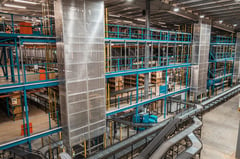
AMRs in the spotlight: Supermarkets and groceries
Given how logisticians refer to AMRs as the definitive future of warehousing, one might assume that the automation technology sector is so profitable that these initials stand for "always making returns." Yes, Autonomous Mobile Robots are an amazing leap forward, and the present many excellent advantages for several different areas of the market.
But are they really the way forward for every sector.
This week the Invar Group continues our examination of the applicability of AMRs into the wider space of warehousing and intralogistics in the economy more broadly. We’ll be looking into where they work best, where they might not fit so well, and more importantly asking the question – why?
Supermarkets and groceries – A-Tier
While not at the elite peak of the S-Tier, supermarkets and grocery sellers are all primed and ready to make use of the revolutionary advantages offered by AMRs. Thanks to a wide range of factors, supermarkets are very well suited to take advantage of all the excellent benefits offered by the AMR revolution.
Digital flowthrough – Much like B2C ecommerce, supermarkets and grocery merchants are very well placed when it comes to online selling. With an AMR fleet installed, a customer’s grocery order can flow through directly and easily with no need for manual intervention. Given the number and complexity of orders coming into grocery stores, this is a huge advantage for supermarkets and is a major reason why so many are looking into AMR deployments.
Order complexity, size, and grouping – One reason AMRs have slightly more applicability in B2C e-commerce compared to supermarkets and groceries is the order sizes. For B2C ecommerce, pieces-per-order are generally at the lower end. Between three to five, or sometimes up to six-to-eight, but rarely higher than that.
By contrast, grocery stores have an item-per-order expectation level of well above ten. Most likely more in the fifteen to twenty-five bracket, if not even more. This is a very marginal difference, but it does mark an important distinction between the supermarket sector specifically, and B2C ecommerce more broadly.
However, this does mean that supermarkets and grocery stores are well placed to take advantage of software like GOALS – Grouped Ordering Algorithmic Logistics Systems. Discover more here about how systems like this can really shake things up when it comes to grocery ordering.
Conjunction technologies – Another important reason why grocery stores might be less suitable for AMR deployment than other parts of the B2C e-commerce sector is the need for additional advanced technologies for AMRs to work fully and effectively. Handling more fragile items like fruit, cakes, or individually packaged food items such as crisp packets or frozen puddings can require more delicacy than simple container movements can allow.
There are two ways to solve this. The first is to have an AMR system that has more space dedicated to manual assistance and support. This is a perfectly valid approach, but it does mean that some of the labour-saving advantages of AMRs is lost. More manual management means more chance for error, more concern about speed variations, and overall, less efficiency.
The other way is to integrate more and better automated picking technologies alongside the AMRs to make handling of more delicate food items even more effective. Suction pickers, pressurised sphere grabbers, and other types of robotic hands are all viable and valuable options. But because of the need to supplement AMRs with such technologies, this does slightly decrease AMR applicability in this sector from S-Tier to A-Tier.
Questions of scale and acceleration – One of the main reasons grocery stores may be more hesitant to deploy AMRs compared to other sectors is the nuanced requirement for short-term acceleration and seasonal scaling. While there are certain times of the year where supermarkets are in more demand than others (as anyone who has seen the Christmas rush can verify) this is nowhere near as true for supermarkets as it is for other sectors. Simply put, we need to eat all year round. One of the principal AMR advantages is the ease of deploying additional robots for businesses to better handle peak season. However, for supermarkets, that might not matter so much, given how in demand their services are all year round.
Purpose built warehouse option – While you can have small-to-medium sized businesses working in the whole breadth of the B2C ecommerce sector, there isn’t really such thing as a small niche supermarket. With the scale most supermarkets operate on, it’s a legitimate question for them to ask if they’d want to adapt existing warehouses with AMRs, or if they would rather purpose build an entirely new facility from the ground up and make use of some other arrangement. Possibly a more fixed ASRS (automated storage and retrieval system) that makes use of a static rail system that reaches higher than current AMR options could handle.
When considering AMRs, an outfit the size and scale of a supermarket must do this as one option among many. While static ASRS robotic facilities have gotten some bad UK press thanks to large scale fires at Occado operations in recent years, the truth is these are the exceptions rather than the rule. AMRs have a lot of utility, but for an operation the size of a supermarket, there are other options too.
Small scale deployments – However, supermarkets do have one area where AMR deployment makes immense sense. Their dozens upon dozens of smaller warehouse and logistics sectors found at the non-public back end of their many commercial real-estate deployments. Every brick-and-mortar supermarket features some kind of back-end storage facility. Many of these could be greatly enhanced by AMR deployments of many different kinds. This is why AMRs are such a fantastic and fascinating technology. They have all kinds of applicability, and their flexibility and smaller installation footprint makes them viable to automate all kinds of spaces that have only known manual operation up to now.
Talk to Invar about your options – Perhaps you’re convinced that the supermarket chain you work for should be taking a closer look at AMRs for the sake of your future. Or maybe you think your area needs rail-based ASRS or some other solution. If you are thinking either of these, or you’re just not sure and want to know more, talk to the Invar Group today.
Written by

Michael Trimmer

Contact Us
Contact us for further independent advice on transforming operational performance in the warehouse.
Contact usRelated Articles

Wincanton acquires Invar to accelerate robotics and automation transformation
Wincanton, a leading supply chain partner for UK business, has agreed to acquire Invar Group...
Read More
Five reasons maintenance matters
When assessing a new technology to automate your warehouse, it’s natural to focus on its...
Read More
Does the Budget aid warehouse automation?
The Chancellor’s Spring Budget could help businesses looking to boost warehouse performance through...
Read More